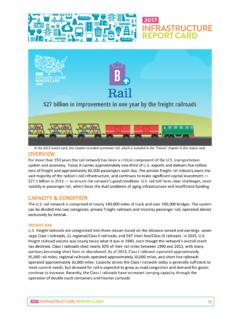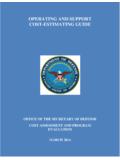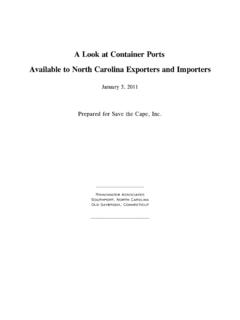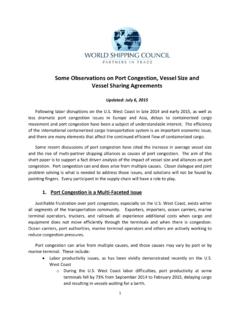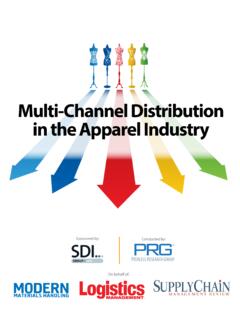Transcription of Life Cycle Costing for Building Services - Urban Template
1 life Cycle Costing for Building ServicesScott West Jacobs Engineering Fort WorthWhy life Cycle Costing ? Increased emphasis on sustainability and energy efficiency Investing in systems that save energy generally must be justified or at least quantified in a financial manifestationLCC or WLC? L ife Cycle Costing versus Whole life Costing These two terms are not mutually exclusive nor are they necessarily synonyms The terms are often used interchangeably however In the UK, WLC is most common but it is used in a context in line with the LCC definitionBS ISO 15686-5 definition from Figure 2 For the Record L ife Cycle Assessment (LCA) the method of measuring and evaluating the environmental impacts associated with a product, system or activity, by describing and assessing the energy and materials used and released to the environment over the life Cycle Therefore LCA is not considered further in this presentationLife Cycle cost Types for Building Services Capital Costs Operational & Maintenance Costs End-of- life Costs and Residual ValueInitial, Construction or Capital Costs F or Building Services the capital cost for LCC should include both the equipment procurement cost and the installation cost (installed cost figure) Early stage work can use rules of thumb ( 5,000/kWp for PV installed cost )
2 , but detailed design stages should use actual quotes from contractors/suppliers Widely considered the most certain cost items of the life Cycle as these costs occur in the present or near-presentOperational & Maintenance Costs E nergy Costs Maintenance Costs Preventative Corrective Deferred Cleaning These costs are relatively uncertain by nature Energy costs are considered more volatile than Maintenance costs which tend to track inflationEnd-of- life Costs and Residual Values R esidual values of Building Services ( an old boiler) are mainly valued for scrap when replacement time arrives Removing old Services equipment requires labour and thus a disposal cost Environmental concerns with old equipment such as asbestos containing materials, can add to disposal costs at end-of- life Disposal costs are also typically included in the capital cost of undertaking equipment replacement or refurbishment, thus for most Building Services projects disposal costs are assumed to counteract any salvage costs leading one to ignore both in a comparative analysis.
3 This is not always the case, but is a sound assumption for most small and medium Building size applicationsClient Should Agree Scope & Objectives of LCC T here are different ways of using and conducting LCC Client has fixed budget and they want to spend all of it on positive NPV projects ranked in order of financial benefit Simple comparative analysis between two projects where only one gets chosen based on financial merit Client may simply want to see that a higher capital cost is worth the added investment in order to produce energy cost savingsService life of Plant & Equipment C hoosing a realistic service life period for equipment is very important to ensure accurate valuation When comparing plant options with different service lives, this variable becomes even more important and mid-study plant replacement costs should be considered A good source for service life expectancies is CIBSE Guide M Maintenance Engineering & Management Appendix Value of Money The value of money fluctuates with time Central banks like the Bank of England and the US Federal Reserve Bank tend to encourage moderate inflation in the 2-3% range YOY.
4 Recommend an inflation rate assumption of 3% YOYHow Does LCC Account for Inflation? I nflation is typically embedded in operational and maintenance cost figures and the discount rate Maintenance costs tend to track general inflation Energy cost fluctuations are more volatile than general inflation LCC is typically presented in real cost figures to avoid over-complication (this method is also required for public sector projects)Selecting a Discount Rate R epresents the opportunity cost of capital over time Similar investments could be discounted at the firms hurdle rate (or weighted average cost of capital, WACC) Could be the yield on an interest bearing account or sinking fund Yield on government bonds (so called risk free rate of return) Average returns from previous similar projects Real versus Nominal discount rate Nominal rate includes inflation Real rate excludes inflation ( The nominal discount rate for an investment is 7%, general inflation is assumed at 3%, thus the real discount rate is 4%)Selecting a Discount Rate O pportunity cost ultimately depends on the condition of the client s firm at any given time and the macro economic environment, for instance what rates the central banks are offering ( LIBOR & Fed funds rate)
5 The economic environment in most of the world in the last decade has been one of cheap money meaning interest rates have been low, this encourages borrowing and discourages savingSelecting a Discount Rate A firm s hurdle rate is typically their WACC If a company s financial structure is 60% equity/40% debt, the expected return on equity by investors is 8% and the corporate bonds were issued at 5%, then the WACC is ( * + * ), thus a company s operational projects should meet or exceed this return figure in order to meet stakeholder obligations (this figure is a nominal interest rate and thus still includes inflation) A firm s hurdle rate can also be different for different asset classes For instance plant replacement could be considered essential foroperations with funding out of general operating budgets or sinking funds, thus the opportunity cost could be lower than the firm s WACC (for instance a bank or bond interest rate)Selecting a Discount Rate T here is no consensus on discount rate selection, it is a matterof personal preference and client methodology There is a standard figure for public sector projects in the UK however which is also a good default figure for the private sector.
6 This figure is provided by HM Treasury Greenbookand is for projects 0-30 years in duration (typically adequate for Building Services ) The rate of is a realdiscount rate and thus does not include inflation (or has inflation already removed)Selecting a Discount Rate T he US Government also requires a particular discount rate to be used for public Building projects, this rate changes annually The realdiscount rate for 2010 is This rate is dictated by 10 CFR 436 which states that the rate is derived from a 12 month moving average for all US Treasury bonds over 10 years in duration with a ceiling of 10% and a floor of 3% (current moving average for the last 3 years is actually only as a result of Fed ZIRP) Annual inflation rates are determined by the President s Council of Economic AdvisorsEnergy Prices E nergy prices are more volatile than general inflation and, on average, escalate at a higher rate Energy prices depend on many complex factors Political stability in fossil fuel producing countries and distribution networks ( pipelines and ship tankers) Rate of discovery of new raw sources, extraction, refinement and distribution Demand from various industries and countries The possibility of peak oil.
7 The depletion of fossil fuel resources Monetary influences ( quantitative easing and currency devaluation)Energy Prices F or public projects in the US, the Department of Energy Energy Information Administration (DOE-EIA) recommends energy escalation rates for projects based on region in the US on an annual basis for LCC Escalation rates are provided for: Electricity Oil LPG Natural Gas CoalEnergy Prices E nergy price trends in the UK are now handled by the Department for Energy and Climate Change (DECC) Once again, energy price escalation rates for LCC are a matter of personal or client preference While historical price trends are important, many difficult to predict factors go into estimating future energy prices which is essentially what is being attempted with LCC Energy market watchers can spend their entire careers analysing and predicting future energy prices Building industry professionals should therefore go with average views and trends For Building Services applications I recommend an energy price escalation figure of 3% annually (this is an escalation rate over-and-above general inflation)
8 Tracking Fossil Fuel Market Prices C rude Oil (futures markets) US West Texas Intermediate: Cushing, Oklahoma (New York Mercantile Exchange or NYMEX) UK/Europe Brent Index: North Sea (Intercontinental Exchange or ICE) Natural Gas US Henry Hub: Intersection of 13 gas pipelines in Erath, Louisiana (NYMEX) UK National Balancing Point (NBP): Virtual trading location, unlike Henry Hub (ICE)Water Prices W ater prices in the UK are set by industry regulator Ofwat Water price changes are somewhere between general inflation and energy costs in volatility Average realyear-over-year increases in water costs (in the UK generally) over the last two decades come to about 2%Conducting LCC Analysis With so many figures floating around at different points in time it can help to produce a Cash Flow Diagram to visualise the problemDiscounting Cash Flows D iscounting a single cash flow to present value Single Present Value (SPV) FactorPV = Present valueExample.
9 CN = Cash flow at year NC10= 1,000N = Year of cash flowi = = Interest rate (discount rate)N = 10 yearsDiscounting Cash Flows A nnually Recurring Costs (Annuity) Uniform Present Value Factor (UPV)PV = Present valueExample:A = Annual recurring cash flowA = 1,000N = Number of yearsi = = Interest rate (discount rate)N = 10 yearsDiscounting Cash Flows A nnually Recurring cost with Escalation Rate ( Energy Usage) Modified Uniform Present Value Factor (UPV*)PV = Present valueExample:A = Annual recurring cash flowA = 1,000N = Year of cash flowi = = Interest rate (discount rate)N = 10 yearse = Escalation ratee = 3%Analysing LCC Results F orm of results Net present value (NPV) Internal rate of return (IRR) Simple pay back period (PBP) Discounted PBP Net Savings (NS) Saving to investment ratio (SIR) Adjusted internal rate of return (AIRR) The form of results is typically dictated by the client, certain types have advantages & disadvantagesNet Present Value T he sum of the present values of the individual cash flows in a given project (discounted cash flows) Projects with a positive NPV create value (are profitable) NPV is scalableNPV = Net present valueExample.
10 CN = Cash flow at year NC0 = 1,000 ( cost )N = Year of cash flowC1 = C2 = 500 (savings)i = Interest rate (discount rate)i = Rate of Return I RR defines the discount rate that produces a NPV of zero (or the rate at which the costs equal the benefits of the investment) The resulting IRR of an investment should then be compared to the company s hurdle rate or WACC If the IRR > WACC, then the project adds value If the IRR < WACC, then the project decreases value IRR should be used with caution because it is possible for an capital project to have more than one rate of return that results in a NPV = 0, this can occur in Building Services projects when plant replacements result in negative cash flows in future years IRR must be calculated by iteration, therefore computers are best suited for IRR calculationsNPV = Net present valueCN = Cash flow at year NN = Year of cash flowi = Interest rate (IRR)Simple Payback Period U sed for simple LCC, essentially ignoring discount, inflation and escalation rates (not approved for)






